
- Home
- Artist
- David Bates (3)
- David Snyder (4)
- F E. Jamieson (3)
- Francis E. Jamieson (3)
- Georg Selismann (2)
- Giovanni Demartino (3)
- Humphrys (2)
- Illegible Signature (7)
- Jean-michel Basquiat (3)
- John S. Barrows (4)
- Keith Haring (2)
- Lovejoy (3)
- Mystery Artist (6)
- Otterman (3)
- Pablo Picasso (15)
- Remedios Varo (4)
- See Description (30)
- See Photos (3)
- Signed (3)
- Unknown (40)
- ... (4159)
- Brand
- American Art Decor (14)
- Antique (11)
- Coca Cola (10)
- Coca-cola (10)
- Dechane's (9)
- Esso (11)
- Firestone (13)
- Goodyear (13)
- Handmade (19)
- Horlicks (7)
- Madura Coats Treads (10)
- Mobil (12)
- Mobil Oil (11)
- Ovaltine (7)
- Samurai (44)
- Shell (10)
- Signs By Jake (11)
- Texaco (14)
- Unknown (16)
- Winchester (23)
- ... (4027)
- Signed By
- Theme
- Unit Of Sale
- Weight
- 1012 Grams Approx. (2)
- 1068 Grams Approx. (3)
- 1155 Grams Approx. (2)
- 1186 Grams Approx. (2)
- 1228 Grams Approx. (2)
- 1296 Grams Approx. (2)
- 1365 Grams Approx. (2)
- 2268 Grams Approx. (2)
- 3038 Grams Approx. (2)
- 318 Grams Approx. (2)
- 415 Grams Approx. (2)
- 442 Grams Approx. (2)
- 558 Grams Approx. (2)
- 640 Grams Approx. (2)
- 732 Grams Approx. (3)
- 76 Gram (2)
- 778 Grams Approx. (2)
- 882 Grams Approx. (2)
- 900 Grams Approx. (3)
- 980 Grams Approx. (2)
- ... (4259)
Vintage Old Folk Art Michelin Man Bibendum Trade Sign Metal Statue, 1970s
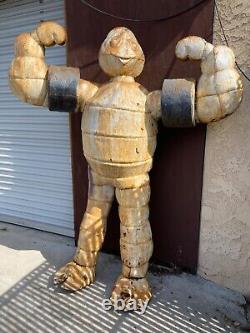
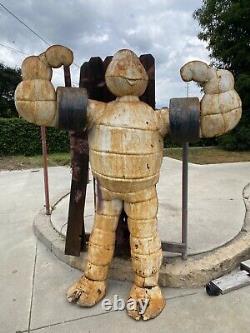
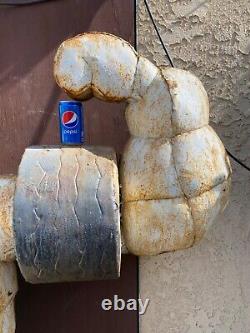
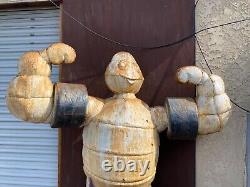
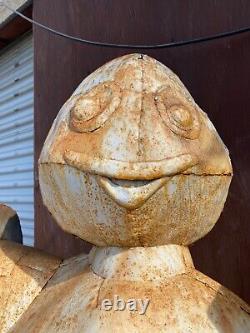
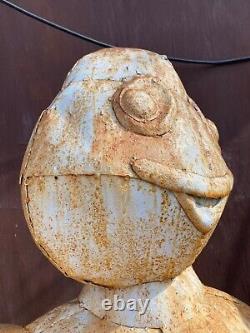
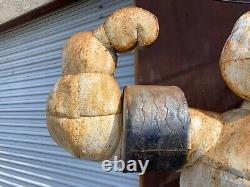
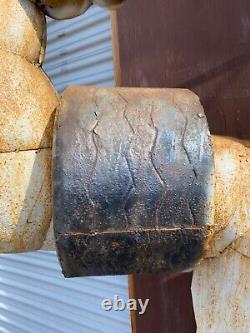
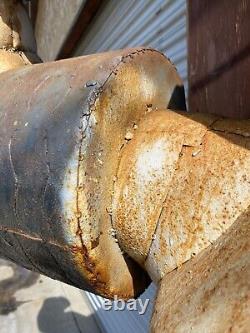
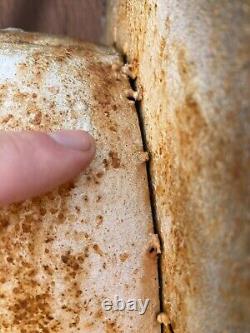
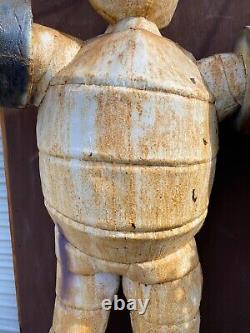
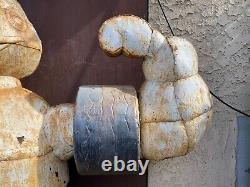
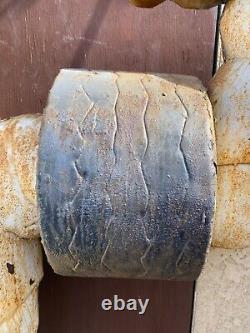
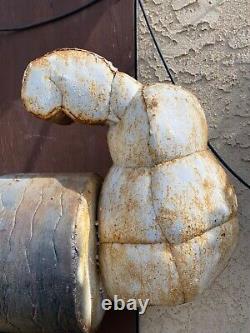
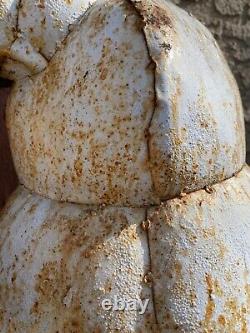
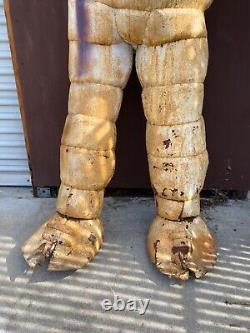
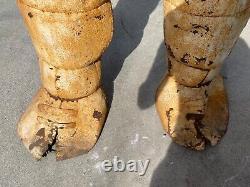
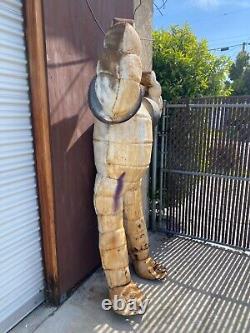
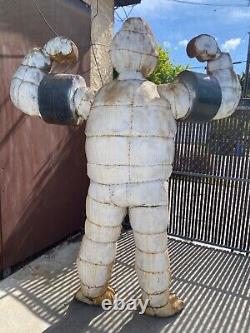
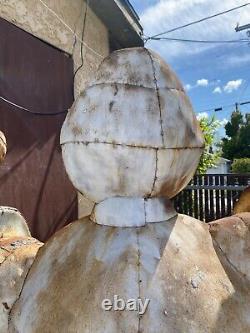
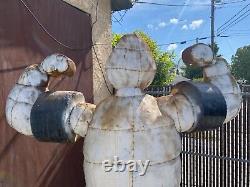
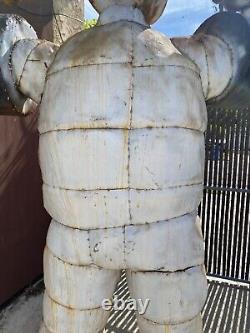
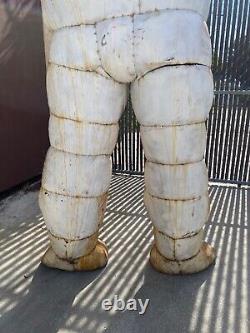
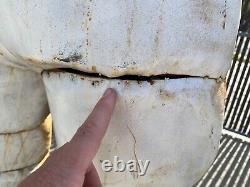


This is an incredibly unique and one-of-a-kind Vintage Old American Folk Art Michelin Man Bibendum Trade Sign Metal Statue, comprised of numerous meticulously crafted pieces of sheet metal, which have been bended and spot-welded to create a three-dimensional and very large sculpture of the iconic Michelin Man, or Bidenbum. This work depicts a smiling tire mascot, standing proud and flexing his arms. Around each bicep is a large tire.
This statue has an inner metal wire frame, and if balanced properly, is completely free-standing. This unusual piece of Folk Art Automobilia likely dates to the 1970's - 1980's, and has expected oxidation, paint loss, broken spot welds, and wear from decades of outdoor display use please see photos. Approximately 80 inches tall x 63 inches at its widest point. Acquired from an eclectic vintage advertising sign and petroliana collection in Los Angeles County, California. You will Never see another one, and it is perfect for any garage or Man Cave.
If you like what you see, I encourage you to make an Offer. Please check out my other listings for more wonderful and unique artworks! They peer at us from cereal boxes, sling products to us from billboards on the drive to work, and await our return home to bombard us with countless TV commercials. Taken for granted today, character-driven advertising didn't really take off until the 20. In the automotive realm, one such pioneering company was Michelin with their character of Bibendum.
Since his official introduction in 1898, Bibendum has taken on several different forms and roles, all while remaining an iconic figure throughout the world. Bibendum is Michelin's metaphorical superhero and, like any comic book character, he comes with a fascinating origin story.
In 1889, French brothers Andre and Edouard Michelin set out to work on what would become the first detachable pneumatic tires. Up until that point, replacement of tires was complicated and time consuming. In fact the brother's quest was inspired by the replacement of a customer's inflated Dunlop bicycle tire, which had been held in place by glue. Their invention made its public debut in 1891 when the tires were used in the Paris-Brest roundtrip bike race.
The brothers viewed the event as an opportunity to demonstrate the benefits of detachable tires, and their sponsored biker Charles Terron delivered on that promise. At one point, he punctured a tire and lost the lead but still managed to emerge in first place. When interviewed, he attributed his victory to Michelin's tires, claiming they were easy to remove and repair. For a time, Terron served as Michelin's spokesman but Andre and Edouard sought a unique way of promoting their product.An epiphany struck Edouard at the 1894 Universal and Colonial Exhibition in Lyon, France. The entrance to the Michelin stand was flanked by two piles of tires, the shape of which Edouard noted to be almost humanlike in appearance. Soon after this chance encounter, the Michelin brothers were approached by the graphic artist O'Galup.
The image he presented was a plump likeness of Gambrinus, the legendary icon of beer brewing. Beer in hand, the figure exclaimed Nun est bibendum!
" Latin for "Now is the time to drink. The Munich brewery O'Galup originally crafted the design for rejected the idea, but Andre and Edouard were intrigued. With the brothers' blessings, O'Galup set out to design Michelin's mascot, finishing the first advertising posters in 1898. The result was a fusion between O'Galup and Edouard's ideas; the mascot was comprised of stacked tires and retained the rotund figure of Gambrinus. O'Galop also ran with the alcohol theme, depicting the Michelin Man raising a toast of broken glass and nails, all while withered looking tire people representing competitors looked on helplessly. The Latin phrase remained intact, with the addition of the motto, the tire that drinks up obstacles.After going public, the Latin phrase was frequently associated with the character, and Bibendum became his adopted name. Like his physical appearance, Bibendum's public persona was larger than life. He was a prominent figure at auto shows and parades, with Michelin employees donning puffy character suits. By 1927, Michelin was interested in marketing the character beyond the sale of tires, and he began appearing on stationary, maps, and automotive gauges.
Candy confectioner Tobler even made a chocolate Bibendum! Michelin ceased manufacturing accessories in 1930 because companies with similar products felt they were facing unfair competition and threatened to boycott Michelin tires. In addition to his visual presence, Bibendum served as the voice of the company.
An example of this was. A 24 page tire maintenance and troubleshooting guide published in 1913.
Bibendum was listed as the editor and signed the forward, yours pneumatically. His figure dominated the cover illustration, in which he was seen providing a demonstration to a massive crowd. The Bibendum of early advertisements was vastly different from the form we recognize today.Prominent features included a big belly, human hands, glasses, and a lit cigar. It's also worth mentioning Bibendum's appearance was less restricted than it is today. Contracts with several different artists contributed to a diverse range of interpretations of the character. Michelin's expanse into foreign markets also gave way to regional variations.
His image became more standardized when Michelin's artwork was done in-house by the 1930s. Bibendum's looks continued to change with the passage of time. As the tire titan entered the roaring twenties, the width of the rings on his body expanded, and his hands became white. His glasses eventually morphed into large round eyes, reminiscent of the then-up-and-coming animated characters like Mickey Mouse.
Bibendum must have also had an intervention because he no longer drank and, with the exception of the occasional relapse, gave up smoking by 1929. In fact, he became more interested in physical fitness. A 1925 poster featured Bibendum running alongside a tire, an image that was to later become a long-standing emblem for the company. This "exercise" paid off, as he is considerably thinner today. In a world where trends come and go Bibendum has stood the test of time, having remained an industry superstar for over a century. To learn more about this legendary mascot, be sure to stop by the library or give us a call. We have a collection of early advertisements, more than 35 Michelin brochures and catalogs and the book.The Michelin Man: 100 Years of Bibendum. Which offers a comprehensive history of the character. We would also be interested in acquiring additional Michelin material to fill in the gaps within our collection. The dark and violent history of the Michelin Man. Listed as one of the most iconic advertising mascots of all time by Business Insider, the Michelin Man's adorably obese, benevolent appearance has charmed generations and helped establish Michelin as a household brand.
However, the character's story is actually a lot deeper and darker than it first appears. For a start, the Michelin Man's name is actually Bibendum, named for the Latin slogan'Nunc est bibendum' which was taken from a collection of poems by Roman poet Horace, and which means "Now is the time to drink". And, although not many would realise it from his cuddly modern appearance, Bibendum used to be absolutely terrifying: a stone cold killer who slaughtered his rivals, smoked heavily and attracted violence and controversy wherever he went. Prior to the character's conception, Michelin at the time not only dominated the French tyre industry but was also one of the world's leading advertisers. Created to be an overlord of the industry and a patriotic expounder of the French spirit at the time, Bibendum was conceived to appeal to the tastes of the burgeoning middle classes and convince them to adopt the automobile along with Michelin as their tyre maker of choice.
In 1898, André Michelin, one of the Michelin company's eponymous founding brothers met French cartoonist Marius Rossillon who showed him a rejected poster he had mocked up for a Munich brewery, which depicted a large bearded man holding aloft a glass of beer. Accompanying the poster was Horace's phrase: "Nunc est Bibendum".
André immediately decided to co-opt the design and suggested replacing the man with a figure made from tyres after having spotted a pile of tyres four years earlier with his brother Édouard and remarking how it resembled a portly man with no arms. The result was the first appearance of the Bibendum character, with a downright creepy layout that replaced the hirsute brewery punter with a corpulent figure composed of animated tyres and which held a glass filled not with beer but with nails and broken glass. Surrounded by anaemic-looking, scrawny competitors, the idea was that just as Rossillon's original character slurped down beer, Michelin's tyre creature could drink up anything thrown at it and continue forward, obstacles and rival businesses alike. Although he was always originally intended to be a creature of jollity, his design showed anything but. While we know him today as a bright-eyed, roly-poly ambassador of goodwill, in the original advertisements the Michelin Man was a grotesque, cadmium-hued phantom.
Sometimes, he chomped on a cigar like a corpulent villain. In other appearances, he wore an inauspicious-looking monocle despite the fact that Michelin wouldn't give him any facial features save for his sinister gaping maw until late in the 20. Powder white, on account of the fact that black tyres didn't appear until 1912 when carbon was added to rubber mixtures to act as a preservative and strengthener, the original Michelin Man was composed of bicycle tyres, giving him a ropey, mummy-like appearance. His rubber-fattened arms, distended and pendulous, were too big to hang by his sides, leaving him to adapt a zombie-like stance and, despite being dreamed up as a sort of pale white Kool-Aid Man, looked just as likely to abduct oncoming motorists and siphon their brains through a straw. Still, that didn't stop Michelin from using this basic character design for a full 15 years, during which time this frightful, tortured mummy creature appeared as a drunkard, a kickboxer and even as an incorrigible ladies' man for the Italian market.
It's important to remember that advertising in that era was very different to how it is today, and in the nascent tyre market, competition was brutal. As a result, so was the Michelin Man.One poster depicts him as a gladiator, one sandaled foot across the throat of a writhing, bleeding rival while three tyre corpses littered the Coliseum behind him. Everywhere he went, the spectral Michelin Man seemed to leave violence in his wake, even as early as his first public appearance at a Paris cycle show in 1898. André Michelin had brought a large cardboard cutout of the character with him and hired a cabaret comedian, hidden behind the scenes, to provide his voice. According to reports, the crowd which formed around him was so large that rival companies became enraged, pushing and shoving so much that police had to be called in order to restore the peace.
Stranger still, in 1907 Michelin launched a travel magazine in Italy and gave the Michelin Man a regular column, ghostwritten by other writers. In one issue, he wrote of various ballroom dances he had attended and praised the local ladies, and in others reported on the crushing impact his own popularity was having on his rivals.
Clearly, this early incarnation was a long stretch from the friendly-faced mascot of today. Fortunately, with iconic status comes a certain responsibility to the public, and as Bibendum became more popular and increasingly widely-known, Michelin's ad designers were forced to tone down his sharper edges. A friendlier, more modern appearance.By the early 1910s the Michelin Man had given up killing and began to strike more playful poses, for example playing Frisbee with tyres or riding a bike, and increasingly defined himself as a motorist's guardian angel rather than a vulcanised autocrat. His behavioural modifications were complemented by physical ones. In an essay on Mickey Mouse, biologist Stephen Jay Gould observed that as company mascots become more popular, they tend to undergo a process known as neoteny, whereby they develop increasingly juvenile characteristics. As a result, Bibendum's head has grown larger relative to his body over the years, and after being given eyes those became increasingly larger as well.
By 1925 he had ditched the monocle and during a tuberculosis epidemic in 1929, he gave up smoking too. These days, the Michelin Man is pristine and smiling, with a trim and more muscular silhouette in response to concerns about obesity, and a million miles from the hard-living instrument of the occult he was originally depicted as.
It's amazing to think that Bibendum has been promoting tyres since 1898 and even more amazing still given his early exploits. Although he isn't the oldest corporate mascot, having been beaten to the pip by the Quaker Oats Pilgrim who dates back to 1877, he's still one of the best-loved characters in history. Drawn, painted, sculpted, die-cast, injection-moulded and animated in more postures than thousands of his rivals put together, he even predates pop culture icons like Betty Crocker, the Jolly Green Giant and Mickey Mouse.
With a fluffy appearance and cute demeanour like the Stay-Puft Marshmallow Man, modern Bibendum kisses babies at motoring shows, embodying the words "rubber" with none of the kink and "Michelin" without the snobby, foodie connotation. Let's all be thankful, then, for this modern, cuddly and overtly amicable character. After all, it's not that long ago that if you found yourself stranded in a dark wood with a puncture, the Michelin Man would have been the last person you would have wanted to see.
